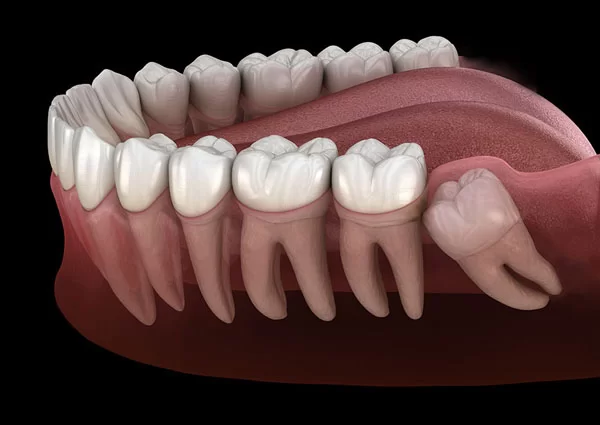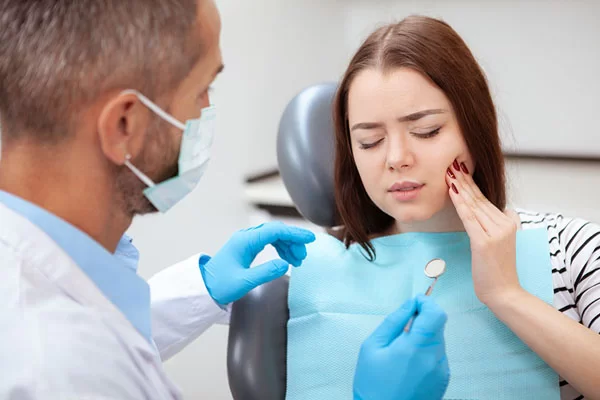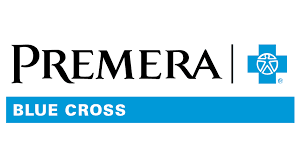Are Your Wisdom Teeth Impacted?
If you’ve ever felt persistent pain or discomfort in the back of your mouth, it could be more than a passing issue. Wisdom teeth impactions are a common problem that can lead to pain, swelling, and even damage to nearby teeth.
At Petrie Advanced Dental in Tacoma, WA, we’re here to help. Tacoma, WA, dentist explains the different types of wisdom teeth impactions so you can understand your condition and take the first step toward relief. Need your wisdom teeth removed? Call our Tacoma dental office today at (253) 761-5422 to schedule your consultation.

What Is a Wisdom Tooth Impaction?
Wisdom teeth impactions occur when the third molars don’t have enough room to fully emerge from the gums. This can cause oral health problems like:
- Cavities: Hard-to-reach areas become vulnerable to decay.
- Gum Disease: Impacted teeth can trap food and bacteria, leading to infection.
- Infection: Partially erupted teeth create an opening for bacteria.
In many cases, surgical removal is the best solution to prevent or address these complications.
Four Main Types of Wisdom Teeth Impactions
There are four main types of wisdom teeth impactions:
- Mesial (angular) impaction
- Vertical impaction
- Horizontal impaction
- Distal impaction
Mesial (Angular) Impactions
Mesial impactions are the most common type of wisdom tooth impaction. This impaction is caused when the tooth is partially erupted and tilted toward the front of the mouth rather than toward the back. This position can cause pressure against neighboring teeth, causing misalignment or damage.
The decision to extract a mesial-impacted tooth depends on several factors, such as the angle of the tooth and the extent to which it’s impacted. Dentists may monitor mesial impactions if the angle is mild but recommend extraction if the positioning threatens oral health. This allows them to monitor any changes in the tooth’s position and assess the potential risk to surrounding teeth before taking action.
Vertical Impactions
Vertical impactions occur when the wisdom tooth is in the correct but upright position, remaining below the gums as it fails to fully erupt. While often harmless and not needing extractions, vertical impactions can sometimes cause pressure on the jawbone or adjacent teeth or displace a neighboring molar, leading to oral health complications.
In these cases, our dentist may suggest surgical removal of the vertically impacted tooth to prevent further damage and alleviate any discomfort.
Horizontal Impactions
Horizontal impactions, whether partially or fully impacted, happen when the tooth lies sideways under the gum, pressing against neighboring teeth. This type of impaction is often painful and can severely damage adjacent teeth or the jawbone.
Surgical extraction is recommended to remove the horizontally impacted wisdom teeth and prevent further complications. It may also be necessary to remove some of the jawbone to extract the impacted tooth successfully. Removing the horizontally impacted tooth can prevent further damage to surrounding teeth and alleviate any pain or discomfort associated with the impaction.
Distal Impactions
Distal impactions are relatively rare and occur when the wisdom tooth is angled towards the back of the mouth. Depending on the tooth’s position, distal impactions may pose little risk or necessitate removal. X-rays help determine whether extraction is required.
Additional Types of Impaction
Wisdom teeth impactions can also be categorized as:
- Soft Tissue Impaction: The tooth is trapped under gum tissue.
- Partial Bony Impaction: The tooth is partially embedded in the jawbone.
- Complete Bony Impaction: The tooth is entirely encased in bone, making extraction more complex.

Symptoms of Impacted Wisdom Teeth
The most common symptoms of impacted wisdom teeth include:
- Persistent pain or discomfort.
- Swelling or inflammation near the back molars.
- Difficulty opening your mouth or chewing.
- Foul breath or taste in your mouth.
- Changes in bite alignment.
Sometimes, impacted wisdom teeth don’t show symptoms but still cause underlying damage. Regular dental exams and X-rays are essential to catch issues early.
How Our Tacoma Dentist Diagnoses The Type of Tooth Impactions
At Petrie Advanced Dental, our dentist in Tacoma evaluates wisdom teeth using:
- Dental X-rays: Visualize the position and angle of the tooth.
- Physical Exam: Assess symptoms like swelling or tenderness.
- Health History: Review any past or current oral health issues.
This comprehensive approach helps determine the type of impaction and the best course of treatment.

Frequently Asked Questions
What is the most common type of wisdom tooth impaction?
Mesial impactions are the most common type of wisdom tooth impaction, often referred to as “angular impactions” due to the teeth being partially erupted and angled towards the front of the mouth.
What are the different types of impaction?
There are three types of impaction: soft tissue, partial bony, and complete bony. Soft tissue impaction occurs when there’s not enough room to allow the gum tissue to retract, whereas partial bony impaction is when there’s enough space to allow the wisdom tooth to partially erupt, and complete bony impaction occurs when there’s no space for the tooth to erupt.
What is the most difficult wisdom tooth impaction?
Complete bony impactions and horizontal impactions are the most challenging due to their positioning and depth in the jawbone.
Contact Petrie Advanced Dental Today for a Consultation
We’re dedicated to providing high-quality care to patients in Tacoma, Lakewood, Federal Way, Puyallup, Gig Harbor, and University Place. With advanced technology and personalized treatment plans, we’ll ensure your procedure is as comfortable and efficient as possible.
Contact us today at (253) 761-5422 to schedule your wisdom teeth consultation. Don’t wait until symptoms worsen—early treatment can protect your smile and oral health.





















